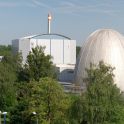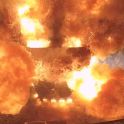
Controlling design basis accidents in nuclear power plants: researchers test simulation codes for passive safety systems
What are active and passive safety systems?
In nuclear power plants, an extensive repertoire of safety systems ensures that the plant is transferred into a safe state in the event of an incident. A distinction is made between active and passive safety systems. Active systems require electrical power supply, e.g. for pumps or valves, to fulfil their functions. Passive systems are characterised by the fact that no external energy is required for activation or operation. The driving forces are based solely on physical laws such as gravitation, condensation or evaporation.
In German nuclear power plants, active safety systems are predominantly used. However, the international trend in the development of new reactor concepts is towards the increased use of passive systems. The reason for this is that they have a low dependence on external influences and on the operation of necessary auxiliary systems.
Experiments at the world's largest test stand for passive systems
What is special about the EASY project is that the researchers have verified the results of their analyses by experiments at the Karlstein integral test facility (INKA) of FRAMATOME GmbH in Karlstein. The test facility is the largest of its kind in the world. It can be used to test the interaction between various passive components of FRAMATOME's innovative boiling water reactor concept KERENA, such as the emergency condenser or the passive core flooding system, on a 1:1 height scale under typical accident conditions. The centrepiece of INKA are four pressure vessels with a height of up to 30 metres and a volume of up to 350 cubic metres.
Validation of the systems with GRS simulation codes
The aim of the project was to further develop simulation tools for the investigation of accidents in nuclear power plants with passive systems and to validate them on the basis of INKA test results. The experts wanted to test two GRS simulation codes: ATHLET and COCOSYS. ATHLET is a program for the analysis of the dynamic behaviour of the reactor and the cooling circuits of a nuclear power plant in the event of leaks and transients. COCOSYS can be used to simulate design basis and severe accident sequences in containments of light water reactors. Both codes are essential components of the GRS AC2 code system and are used, for example, to verify whether certain accidents can be controlled.
The codes were originally developed for reactors with predominantly active safety systems. Passive systems represent a challenge for the calculation with simulation codes – among other things due to the low driving forces. Their ability to calculate the characteristics of passive systems (e.g. temperature stratifications in large water pools, small differences in temperature or pressure) must therefore be further developed and validated for passive systems. It should therefore be clarified within the research project how well the two simulation codes are able to predict the behaviour of passive systems being dependent on a large number of continuously changing parameters.
Results of the project
In the project, the integral experiments performed in INKA were recalculated with the GRS simulation codes ATHLET and COCOSYS. It was shown that for these experiments the ATHLET system code is able to simulate the phenomena in the reactor coolant system and the containment well. In addition, the containment was simulated in the experiments with the COCOSYS containment code. For this purpose, GRS experts use a coupled version of the two programs ATHLET and COCOSYS. It turned out that a coupling of both programs also leads to a good agreement with the experimental data, but the coupling itself must be further optimised in order to improve its stability. Furthermore it showed that the simulation of the passive heat exchangers for residual heat removal from the reactor coolant system and the containment is very demanding for both programs. Together with the further development of the ATHLET/COCOSYS coupling, it will therefore remain an important topic for safety research at GRS in the future.
The experiments also showed that the passive systems of the KERENA design worked effectively both component by component and in their interaction and meet the requirements. Even though passive systems are only used to a limited extent in Germany, the research results support Germany in independently assessing the safety of nuclear power plants abroad and in keeping the tools for this up to date with the state of the art in science and technology.
Project highlights Reactor Safety

Research reactors differ considerably in design and use from commercial reactors in nuclear power plants. GRS researchers are looking at how these differences affect the safety of research reactors.

GRS is currently conducting research in the HEAF projectof the Committee on the Safety of Nuclear Installations (CSNI) on the subject of fire protection in nuclear installations. The CSNI is an international body of the Nuclear Energy Agency (NEA) of the Organisation for Economic Cooperation and Development (OECD). It coordinates all NEA projects dealing with the safety of nuclear installations.